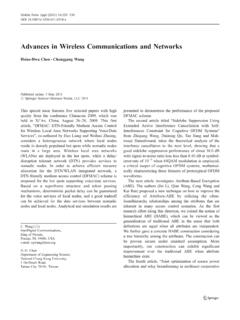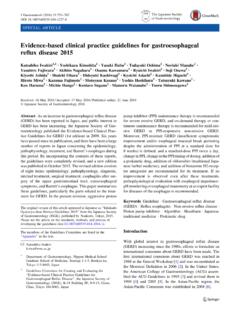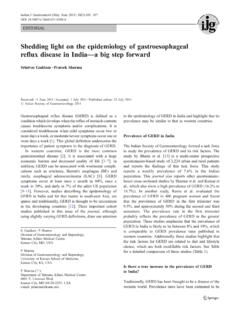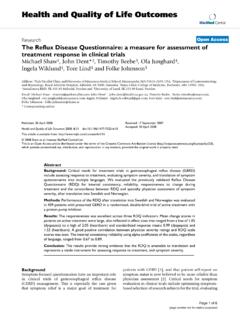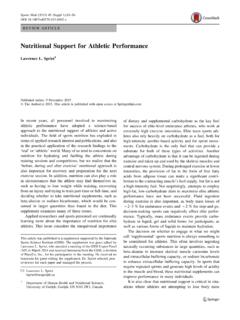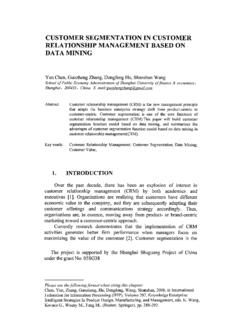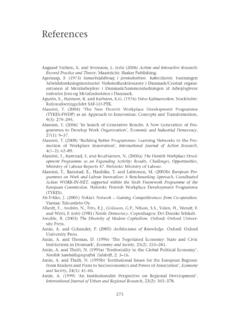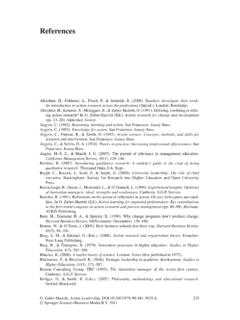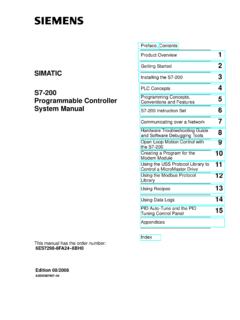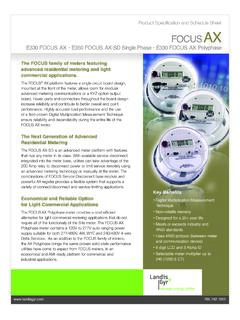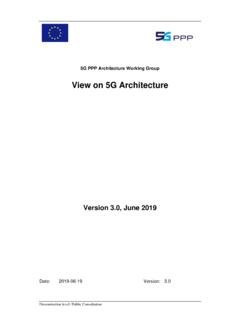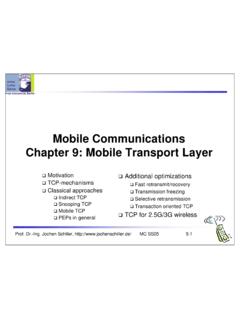Transcription of 4G Mobile Network Architecture - Springer
1 4g mobile network architecture Kalle Ikkel , Marko Myllynen, Juha Heinanen and Olli Martikainen Lappeenranta University of Technology, 20, 53851 Lappeenranta, Finland { , Key words: 4G, SIP, mobility, GSM. Abstract: The convergence of telecommunications, computing, and content industries has been one of the major trends during recent years. The convergence has led to the creation of a wide range of multimedia services that are available in digital form through the Internet. There is a need for user and terminal mobility supporting both personal communication and multimedia services on top of the Internet. To help meet this need, this paper presents ongoing research on the Fourth Generation (4G) roaming and mobility model. The 4G. model is compatible with existing IP standards. The basic elements of the model are described and the model is compared to the GSM (2G) model. 1. INTRODUCTION. Traditional telecom and content services are vertically integrated. Each service depends on a dedicated Network and corresponding terminals.}
2 Examples of such vertical services are the fixed telephone services, traditional data services and GSM services. Internet changes the vertical structure to a horizontal one: all terminals and services will be Internet compatible. Instead of vertical service "pipes" there will be a horizontal structure of services, Network and access, as illustrated in Figure 1. 184 Kalle Ikkel , Marko Myllynen, Juha Hein nen and Olli Martikainen Figure 1. Vertical service pipes compared to horizontal service structure The horizontal structure will change terminals, services, and the way services are managed. The horizontal structure will allow different combinations of service functionalities in the terminal equipment as depicted in Figure 2. The ovals show possible combinations of services in single terminals. Horizontal networks will not only make existing services easier and more widely applicable, but also create a platform for the integration of various new services and applications into the same terminals.
3 New terminal applications in horizontal networks can be divided into simple fixed-purpose terminals and intelligent terminals. Possible fixed- purpose terminals can be wearables (watches, eyeglasses, clothes) or appliances (light switches, doors, micro-ovens). Intelligent terminals include Personal Digital Assistants (PDA), Smart Phones or Media Terminals. Simple terminals will connect to Personal Area Networks (PANS) or Domestic Area Networks. Intelligent terminals apply to Local Area Networks (LAN) or public access networks. They will have software and content-defined functionalities that allow various applications within one device. 4g mobile network architecture 185. Figure 2. Restructuring to multifunction terminals and horizontal services Fourth Generation Mobile (4G) means broadband Mobile wireless services, which are based on IEEE Wireless LAN (WLAN) [1] or Bluetooth (Bt) [3] access, IP mobility and Web type services. The radio access can be connected to private corporate LANs, public administration LANs, Mobile WLANs installed in trains, airplanes, buses or cars and to single DSL connections.
4 Corporate offices, shopping centers, hotels, airports, home networks, and personal area networks (PAN) will be the leading adopters of these technologies. The client devices for the 4G. applications can be categorized as follows: .. Laptop PC with WLAN. Laptop PC with Bt .. PDA with WLAN. PDA with Bt .. Dual-mode wireless phone with GSM and WLAN or Bt Wireless phone with Bt Other specialized Bt devices. 186 Kalle Ikkel , Marko Myllynen, Juha Hein nen and Olli Martikainen 2. Architecture OF GSM AND UMTS. NETWORKS. An overview of a GSM Network Architecture is presented in Figure 3. A. GSM Network is composed of several functional entities, whose functions and interfaces are defined. The GSM Network can be divided into three parts: The Mobile Station (MS), carried by the subscriber; the radio link, controlled by the Base Station Subsystem (BSS) with the Mobile station; the Mobile services Switching Center (MSC). The MSC is the main part of the Network Subsystem and performs the switching of calls and management of Mobile services, authentication, for example.
5 The operation and setup of the Network is managed by the Operations and Maintenance Center (OMC). Each component dealing with mobility is described in more detail next. Figure 3. GSM Network overview Mobile Station (MS): The Mobile station is the user terminal, which consists of a radio transceiver, signal processors, display, and a Subscriber Identity Module (SIM card). The SIM card enables the usage of services and personal mobility. 4g mobile network architecture 187. Base Station Subsystem (BSS): The Base Station Subsystem has two components, the Base Transceiver Station (BTS) and the Base Station Controller (BSC). The radio transceivers are located in BTSs. The BTS also manages the radio-link with MS. The Base Station Controller manages one or more BTSs and handles radio resources, such as radio-channel setup, frequency hopping, and handovers. Mobile Services Switching Center (MSC): The Mobile services Switching Center is the central component of the Network Subsystem.
6 MSC. is like a normal switch in PSTN or ISDN. MSC also handles all the functions needed to manage Mobile subscribers, including registration, authentication, location updating, handovers and call routing. The roaming functionality of GSM is provided by the Home Location Register (HLR) and Visitor Location Register (VLR) together with the MSC. The MSC has no information about particular Mobile stations; this information is stored in VLRs and HLRs. Home Location Register (HLR): This functional entity is a data base in charge of the management of Mobile subscribers. A Public Land Mobile Network (PLMN) may contain one or several HLRs. The number of HLRs depends on the number of Mobile subscribers, on the capacity of the equipment and on the organization of the Network . The HLR contains two kinds of information: subscription information and some location information that enables the charging and routing of calls toward the MSC. where the MS is located ( , the MS roaming number, the MSC address).
7 Visitor Location Register (VLR): This controls Mobile stations roaming in the MSC area it is in charge of. When a Mobile station enters a new location area it starts its registration procedure. The MSC in charge of that area notices this registration and transfers the identity of the location area where the MS is situated to the Visitor Location Register. If this MS is not yet registered, the VLR and the HLR exchange information to allow the proper handling of calls involving the MS. Areas of the GSM Network Different areas of GSM Network and the functions associated with them are described below. Location area (LA): The location area is defined as an area in which a Mobile station may move freely without updating the location register. A. location area may consist of several cells. Network coverage area: An area in which Mobile stations are able to communicate with the Network . 188 Kalle Ikkel , Marko Myllynen, Juha Hein nen and Olli Martikainen Service area (SA): An area in which a Mobile station is obtainable by another PLMN, PSTN or ISDN subscriber without the subscribers knowledge of the actual location of the Mobile station within its area.
8 System area: The system area consists of one or more service areas with fully compatible MS-BS interfaces. The location registers of the individual service areas remain autonomous; updating of the location information is not performed when roaming Mobile station moves from one service area to another. Roaming and Handover Roaming is the movement of the Mobile terminal from one part of the Network area to another part, while retaining the capability of making or receiving calls. The handover is the action of switching a call in progress from one cell to another (or between radio channels in the same cell). The handover is used to allow established calls to continue when Mobile stations move from one cell to another. The handover can be carried out in several ways: Intracell handover: The Mobile unit is switched from one channel to another within the cell area. BTS-BTS handover: The Mobile station is switched from one Base Transceiver Station to another under the control of the same Base Station Controller.
9 BSC-BSC handover: The Mobile station switches between BTSs as well as between the BSCs at the same time. The handover is controlled by the target BSC. MSC-MSC handover: When switching between the BTSs and BSCs, the Mobile station may also switch from one MSC ( Mobile Services Switching Center) area to another. The handover is controlled by the target MSC. Packet radio ( gprs and UMTS). GSM in phase 2+ will be capable of handling both the conventional circuit switched transmission already introduced in GSM Phase 1 and the packet switch transmission provided by the gprs (General Packet Radio Service). gprs and UMTS are both based on broadband radio technologies. as distinct from GSM Phase 1. The evolution from GSM towards UMTS. (3G) happens slowly, with gprs gradually adding SGSN (Serving gprs . Support Node) and the GGSN (Gateway gprs Support Node) elements to the GSM Architecture (Figure 4). The circuit switched transmission path 4g mobile network architecture 189.
10 Between the GSM BSS (Base Station Subsystem) and external networks is routed through the GSM Network via the MSC ( Mobile Services Switching Center) and the GMSC (Gateway MSC), while the packet switched transmission is routed via the gprs components SGSN (Serving gprs . Support Node) and the GGSN (Gateway gprs Support Node). The UTRAN. (UMTS Terrestrial Radio Access Network ) will be interconnected to this core Network via two NUS (Inter Working Units), one between the Iu interface and the GSM A interface, and another between the Iu interface and the gprs Gb interface (see Figure 4). This Architecture makes it possible for both GSM and UMTS customers to be connected both to circuit switched networks ( , PSTN and N-ISDN) and packet switched networks ( the Internet and intranets). Additionally, users should also be able to roam between GSM and UMTS networks. [8]. Figure 4. Evolution of GSM platform towards UMTS. 3. REQUIREMENTS FOR IP MOBILITY. 4G terminals will be used to access various services, including current Internet based services as well as new services targeted for 4G terminal users.
